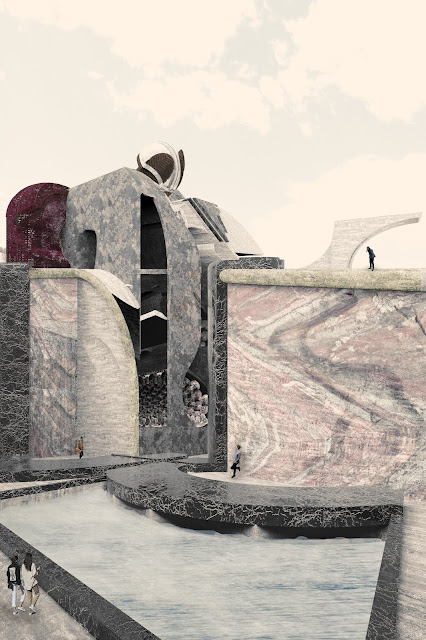T4T LAB Spring 2018. Rough and Saturated
Invited Professor: Nate Hume
Team: Paul Germaine McCoy, Grant Parker and Daniel Enyon
We think that reality and truth are
not separate, and while they are not the same, they engage selectively.
Our project operates, in reality, as
a research and development center for the Texas A&M Department of Wildlife
and Fisheries Sciences with a focus on algae biofuels and aquaponics. The
project started from the simple notion of the line as an object and evolved in
our process. When we projected these lines onto our ensemble, a series of
immanent figures created slippages between the ensemble and the site, resulting
in a difficult whole. Through a series of soap casts and color studies, the
project became saturated with a texture that referenced familiar notions of
material. Yet, while these things all serve to estrange canonical architectural
materials and forms, the truth of our project is that there still lies a deeper
issue of correlationism.
The distortion between reality and
truth is due to the innate perspective of the human. Thus, the state most
informed by the truth within this perspective is reality. As a result of the
distortion, we adopted the method of stitching things together to further
explore the issue of correlationism in a clear way. The stitch brings together
various views of the object to reconstruct a reality based on the epistemology
and ontology of the object. This reconstruction occurs in the manner that
knowledge of the real and the being of the truth are weighted equally. Weighing
these as equal and stitching them together shows the disparity between them
when considered on their own. To allow clarity in this stitching, the drawings,
and the model only give selective sets of information, furthering our argument
by letting the drawings and model act unknowable and false, yet be operatively
real and true. The clarity that occurs in this process lets all the information
be questioned in a detective like game, where the viewer, is given multiple
sets of information and has to sort through where they connect and then wrestle
with what is correct.
We put forward the notion that it doesn’t matter
so much in the traditional sense that the drawings are “correct” or consistent,
but rather that the most important discussion to have is of how we view things.
As a result, we have coined the term “immanent drawings”. These appropriate the
idea that there is manifested, yet unused.































































